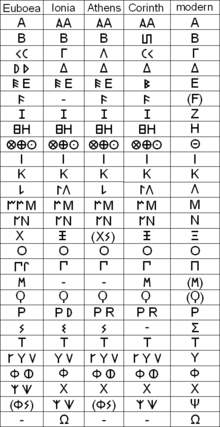Greek language
Greek (Greek: Ελληνικά, romanized: Elliniká) is an independent branch of the Indo-European family of languages, native to Greece, Cyprus, Albania, other parts of the Eastern Mediterranean and the Black Sea. It has the longest documented history of any living Indo-European language, spanning at least 3,500 years of written records.[3] Its writing system has been the Greek alphabet for the major part of its history; other systems, such as Linear B and the Cypriot syllabary, were used previously.[4] The alphabet arose from the Phoenician script and was in turn the basis of the Latin, Cyrillic, Armenian, Coptic, Gothic, and many other writing systems.
| Greek | |
|---|---|
| ελληνικά | |
| Pronunciation | [eliniˈka] |
| Region | Greece Cyprus Asia Minor Balkans Black Sea coast Eastern Mediterranean Southern Italy |
| Ethnicity | Greeks |
Native speakers | 13.4 million (2012)[1] |
Indo-European
| |
Early form | |
| Dialects | |
| Language codes | |
| ISO 639-1 | el |
| ISO 639-2 | gre (B) ell (T) |
| ISO 639-3 | Variously:ell – Modern Greekgrc – Ancient Greekcpg – Cappadocian Greekgmy – Mycenaean Greekpnt – Pontictsd – Tsakonianyej – Yevanic |
| Glottolog | gree1276[2] |
| Linguasphere | |
The Greek language holds an important place in the history of the Western world and Christianity; the canon of ancient Greek literature includes works in the Western canon such as the epic poems Iliad and Odyssey. Greek is also the language in which many of the foundational texts in science, especially astronomy, mathematics and logic and Western philosophy, such as the Platonic dialogues and the works of Aristotle, are composed; the New Testament of the Christian Bible was written in Koiné Greek. Together with the Latin texts and traditions of the Roman world, the study of the Greek texts and society of antiquity constitutes the discipline of Classics.
During antiquity, Greek was a widely spoken lingua franca in the Mediterranean world, West Asia and many places beyond. It would eventually become the official parlance of the Byzantine Empire and develop into Medieval Greek.[5] In its modern form, Greek is the official language in two countries, Greece and Cyprus, a recognized minority language in seven other countries, and is one of the 24 official languages of the European Union. The language is spoken by at least 13.4 million people today in Greece, Cyprus, Italy, Albania, and Turkey and by the Greek diaspora.
Greek roots are often used to coin new words for other languages; Greek and Latin are the predominant sources of international scientific vocabulary.
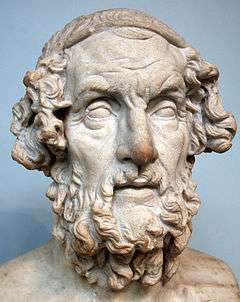
History
Greek has been spoken in the Balkan peninsula since around the 3rd millennium BC,[6] or possibly earlier.[7] The earliest written evidence is a Linear B clay tablet found in Messenia that dates to between 1450 and 1350 BC,[8] making Greek the world's oldest recorded living language. Among the Indo-European languages, its date of earliest written attestation is matched only by the now-extinct Anatolian languages.
Periods
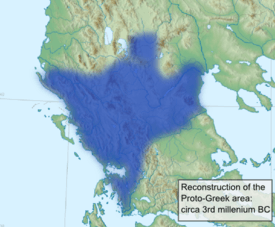
The Greek language is conventionally divided into the following periods:
- Proto-Greek: the unrecorded but assumed last ancestor of all known varieties of Greek. The unity of Proto-Greek would have ended as Hellenic migrants entered the Greek peninsula sometime in the Neolithic era or the Bronze Age. [note 1]
- Mycenaean Greek: the language of the Mycenaean civilization. It is recorded in the Linear B script on tablets dating from the 15th century BC onwards.
- Ancient Greek: in its various dialects, the language of the Archaic and Classical periods of the ancient Greek civilization. It was widely known throughout the Roman Empire. Ancient Greek fell into disuse in western Europe in the Middle Ages, but remained officially in use in the Byzantine world and was reintroduced to the rest of Europe with the Fall of Constantinople and Greek migration to western Europe.
- Koine Greek: The fusion of Ionian with Attic, the dialect of Athens, began the process that resulted in the creation of the first common Greek dialect, which became a lingua franca across the Eastern Mediterranean and Near East. Koine Greek can be initially traced within the armies and conquered territories of Alexander the Great and after the Hellenistic colonization of the known world, it was spoken from Egypt to the fringes of India. After the Roman conquest of Greece, an unofficial bilingualism of Greek and Latin was established in the city of Rome and Koine Greek became a first or second language in the Roman Empire. The origin of Christianity can also be traced through Koine Greek, because the Apostles used this form of the language to spread Christianity. It is also known as Hellenistic Greek, New Testament Greek, and sometimes Biblical Greek because it was the original language of the New Testament and the Old Testament was translated into the same language via the Septuagint.
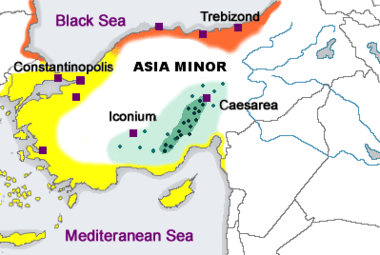
- Medieval Greek, also known as Byzantine Greek: the continuation of Koine Greek, up to the demise of the Byzantine Empire in the 15th century. Medieval Greek is a cover phrase for a whole continuum of different speech and writing styles, ranging from vernacular continuations of spoken Koine that were already approaching Modern Greek in many respects, to highly learned forms imitating classical Attic. Much of the written Greek that was used as the official language of the Byzantine Empire was an eclectic middle-ground variety based on the tradition of written Koine.
- Modern Greek (Neo-Hellenic):[10] Stemming from Medieval Greek, Modern Greek usages can be traced in the Byzantine period, as early as the 11th century. It is the language used by the modern Greeks, and, apart from Standard Modern Greek, there are several dialects of it.
Diglossia
In the modern era, the Greek language entered a state of diglossia: the coexistence of vernacular and archaizing written forms of the language. What came to be known as the Greek language question was a polarization between two competing varieties of Modern Greek: Dimotiki, the vernacular form of Modern Greek proper, and Katharevousa, meaning 'purified', a compromise between Dimotiki and Ancient Greek, which was developed in the early 19th century and was used for literary and official purposes in the newly formed Greek state. In 1976, Dimotiki was declared the official language of Greece, having incorporated features of Katharevousa and giving birth to Standard Modern Greek, which is used today for all official purposes and in education.[11]
Historical unity
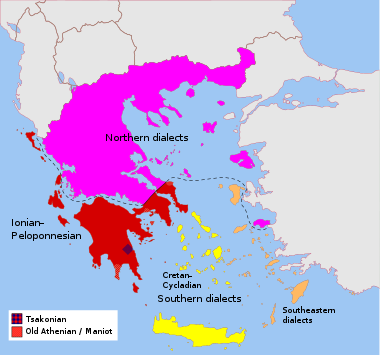
The historical unity and continuing identity between the various stages of the Greek language are often emphasized. Although Greek has undergone morphological and phonological changes comparable to those seen in other languages, never since classical antiquity has its cultural, literary, and orthographic tradition been interrupted to the extent that one can speak of a new language emerging. Greek speakers today still tend to regard literary works of ancient Greek as part of their own rather than a foreign language.[12] It is also often stated that the historical changes have been relatively slight compared with some other languages. According to one estimation, "Homeric Greek is probably closer to demotic than 12-century Middle English is to modern spoken English".[13]
Geographic distribution
.svg.png)

Greek is spoken today by at least 13 million people, principally in Greece and Cyprus along with a sizable Greek-speaking minority in Albania near the Greek-Albanian border.[10] A significant percentage of Albania's population has some basic knowledge of the Greek language due in part to the Albanian wave of immigration to Greece in the 1980s and '90s. Prior to the Greco-Turkish War and the resulting population exchange in 1923 a very large population of Greek-speakers also existed in Turkey, though very few remain today.[3] A small Greek-speaking community is also found in Bulgaria near the Greek-Bulgarian border. Greek is also spoken worldwide by the sizable Greek diaspora which as notable communities in the United States, Australia, Canada, South Africa, Chile, Brazil, Argentina, Russia, Ukraine, and throughout the European Union, especially in the United Kingdom and Germany.
Historically, significant Greek-speaking communities and regions were found throughout the Eastern Mediterranean, in what are today Southern Italy, Turkey, Cyprus, Syria, Lebanon, Israel, Egypt, and Libya; in the area of the Black Sea, in what are today Turkey, Bulgaria, Romania, Ukraine, Russia, Georgia, Armenia, and Azerbaijan; and, to a lesser extent, in the Western Mediterranean in and around colonies such as Massalia, Monoikos, and Mainake.
Official status
Greek, in its modern form, is the official language of Greece, where it is spoken by almost the entire population.[14] It is also the official language of Cyprus (nominally alongside Turkish).[15] Because of the membership of Greece and Cyprus in the European Union, Greek is one of the organization's 24 official languages.[16] Furthermore, Greek is officially recognized as official in Dropull and Himara (Albania), and as a minority language all over Albania,[17] as well as in parts of Italy, Armenia, Romania, and Ukraine as a regional or minority language in the framework of the European Charter for Regional or Minority Languages.[18] Greeks are also a recognized ethnic minority in Hungary.[19]
Characteristics
The phonology, morphology, syntax, and vocabulary of the language show both conservative and innovative tendencies across the entire attestation of the language from the ancient to the modern period. The division into conventional periods is, as with all such periodizations, relatively arbitrary, especially because at all periods, Ancient Greek has enjoyed high prestige, and the literate borrowed heavily from it.
Phonology
Across its history, the syllabic structure of Greek has varied little: Greek shows a mixed syllable structure, permitting complex syllabic onsets but very restricted codas. It has only oral vowels and a fairly stable set of consonantal contrasts. The main phonological changes occurred during the Hellenistic and Roman period (see Koine Greek phonology for details):
- replacement of the pitch accent with a stress accent.
- simplification of the system of vowels and diphthongs: loss of vowel length distinction, monophthongisation of most diphthongs and several steps in a chain shift of vowels towards /i/ (iotacism).
- development of the voiceless aspirated plosives /pʰ/ and /tʰ/ to the voiceless fricatives /f/ and /θ/, respectively; the similar development of /kʰ/ to /x/ may have taken place later (the phonological changes are not reflected in the orthography, and both earlier and later phonemes are written with φ, θ, and χ).
- development of the voiced plosives /b/, /d/, and /ɡ/ to their voiced fricative counterparts /β/ (later /v/), /ð/, and /ɣ/.
Morphology
In all its stages, the morphology of Greek shows an extensive set of productive derivational affixes, a limited but productive system of compounding[20] and a rich inflectional system. Although its morphological categories have been fairly stable over time, morphological changes are present throughout, particularly in the nominal and verbal systems. The major change in the nominal morphology since the classical stage was the disuse of the dative case (its functions being largely taken over by the genitive). The verbal system has lost the infinitive, the synthetically-formed future, and perfect tenses and the optative mood. Many have been replaced by periphrastic (analytical) forms.
Nouns and adjectives
Pronouns show distinctions in person (1st, 2nd, and 3rd), number (singular, dual, and plural in the ancient language; singular and plural alone in later stages), and gender (masculine, feminine, and neuter) and decline for case (from six cases in the earliest forms attested to four in the modern language).[note 2] Nouns, articles, and adjectives show all the distinctions except for a person. Both attributive and predicative adjectives agree with the noun.
Verbs
The inflectional categories of the Greek verb have likewise remained largely the same over the course of the language's history but with significant changes in the number of distinctions within each category and their morphological expression. Greek verbs have synthetic inflectional forms for:
| Ancient Greek | Modern Greek | |
|---|---|---|
| Person | first, second and third | also second person formal |
| Number | singular, dual and plural | singular and plural |
| tense | present, past and future | past and non-past (future is expressed by a periphrastic construction) |
| aspect | imperfective, perfective (traditionally called aorist) and perfect (sometimes also called perfective; see note about terminology) | imperfective and perfective/aorist (perfect is expressed by a periphrastic construction) |
| mood | indicative, subjunctive, imperative and optative | indicative, subjunctive,[note 3] and imperative (other modal functions are expressed by periphrastic constructions) |
| Voice | active, middle, and passive | active and medio-passive |
Syntax
Many aspects of the syntax of Greek have remained constant: verbs agree with their subject only, the use of the surviving cases is largely intact (nominative for subjects and predicates, accusative for objects of most verbs and many prepositions, genitive for possessors), articles precede nouns, adpositions are largely prepositional, relative clauses follow the noun they modify and relative pronouns are clause-initial. However, the morphological changes also have their counterparts in the syntax, and there are also significant differences between the syntax of the ancient and that of the modern form of the language. Ancient Greek made great use of participial constructions and of constructions involving the infinitive, and the modern variety lacks the infinitive entirely (instead of having a raft of new periphrastic constructions) and uses participles more restrictively. The loss of the dative led to a rise of prepositional indirect objects (and the use of the genitive to directly mark these as well). Ancient Greek tended to be verb-final, but neutral word order in the modern language is VSO or SVO.
Vocabulary
Modern Greek inherits most of its vocabulary from Ancient Greek, which in turn is an Indo-European language, but also includes a number of borrowings from the languages of the populations that inhabited Greece before the arrival of Proto-Greeks,[21] some documented in Mycenaean texts; they include a large number of Greek toponyms. The form and meaning of many words have evolved. Loanwords (words of foreign origin) have entered the language, mainly from Latin, Venetian, and Turkish. During the older periods of Greek, loanwords into Greek acquired Greek inflections, thus leaving only a foreign root word. Modern borrowings (from the 20th century on), especially from French and English, are typically not inflected; other modern borrowings are derived from South Slavic (Macedonian/Bulgarian) and Eastern Romance languages (Aromanian and Megleno-Romanian).
Greek loanwords in other languages
Greek words have been widely borrowed into other languages, including English: mathematics, physics, astronomy, democracy, philosophy, athletics, theatre, rhetoric, baptism, evangelist, etc. Moreover, Greek words and word elements continue to be productive as a basis for coinages: anthropology, photography, telephony, isomer, biomechanics, cinematography, etc. and form, with Latin words, the foundation of international scientific and technical vocabulary like all words ending with –logy ("discourse"). There are many English words of Greek origin.[22][23]
Classification
Greek is an independent branch of the Indo-European language family. The ancient language most closely related to it may be ancient Macedonian,[24] which many scholars suggest may have been a dialect of Greek itself, but it is so poorly attested that it is difficult to conclude anything about it.[25] Independently of the Macedonian question, some scholars have grouped Greek into Graeco-Phrygian, as Greek and the extinct Phrygian share features that are not found in other Indo-European languages.[26] Among living languages, some Indo-Europeanists suggest that Greek may be most closely related to Armenian (see Graeco-Armenian) or the Indo-Iranian languages (see Graeco-Aryan), but little definitive evidence has been found for grouping the living branches of the family.[27] In addition, Albanian has also been considered somewhat related to Greek and Armenian by some linguists. If proven and recognized, the three languages would form a new Balkan sub-branch with other dead European languages.[28]
Writing system
| Greek alphabet | ||||||||||||||||||||||||||||||||||||||||||||||||
|---|---|---|---|---|---|---|---|---|---|---|---|---|---|---|---|---|---|---|---|---|---|---|---|---|---|---|---|---|---|---|---|---|---|---|---|---|---|---|---|---|---|---|---|---|---|---|---|---|
|
||||||||||||||||||||||||||||||||||||||||||||||||
| History | ||||||||||||||||||||||||||||||||||||||||||||||||
| Use in other languages | ||||||||||||||||||||||||||||||||||||||||||||||||
| Related topics | ||||||||||||||||||||||||||||||||||||||||||||||||
| ||||||||||||||||||||||||||||||||||||||||||||||||
Linear B
Linear B, attested as early as the late 15th century BC, was the first script used to write Greek.[29] It is basically a syllabary, which was finally deciphered by Michael Ventris and John Chadwick in the 1950s (its precursor, Linear A, has not been deciphered and most likely encodes a non-Greek language).[29] The language of the Linear B texts, Mycenaean Greek, is the earliest known form of Greek.[29]
Cypriot syllabary

Another similar system used to write the Greek language was the Cypriot syllabary (also a descendant of Linear A via the intermediate Cypro-Minoan syllabary), which is closely related to Linear B but uses somewhat different syllabic conventions to represent phoneme sequences. The Cypriot syllabary is attested in Cyprus from the 11th century BC until its gradual abandonment in the late Classical period, in favor of the standard Greek alphabet.[30]
Greek alphabet
Greek has been written in the Greek alphabet since approximately the 9th century BC. It was created by modifying the Phoenician alphabet, with the innovation of adopting certain letters to represent the vowels. The variant of the alphabet in use today is essentially the late Ionic variant, introduced for writing classical Attic in 403 BC. In classical Greek, as in classical Latin, only upper-case letters existed. The lower-case Greek letters were developed much later by medieval scribes to permit a faster, more convenient cursive writing style with the use of ink and quill.
The Greek alphabet consists of 24 letters, each with an uppercase (majuscule) and lowercase (minuscule) form. The letter sigma has an additional lowercase form (ς) used in the final position:
| upper case | ||||||||||||||||||||||||||||||||
|---|---|---|---|---|---|---|---|---|---|---|---|---|---|---|---|---|---|---|---|---|---|---|---|---|---|---|---|---|---|---|---|---|
| Α | Β | Γ | Δ | Ε | Ζ | Η | Θ | Ι | Κ | Λ | Μ | Ν | Ξ | Ο | Π | Ρ | Σ | Τ | Υ | Φ | Χ | Ψ | Ω | |||||||||
| lower case | ||||||||||||||||||||||||||||||||
| α | β | γ | δ | ε | ζ | η | θ | ι | κ | λ | μ | ν | ξ | ο | π | ρ | σ ς | τ | υ | φ | χ | ψ | ω | |||||||||
Diacritics
In addition to the letters, the Greek alphabet features a number of diacritical signs: three different accent marks (acute, grave, and circumflex), originally denoting different shapes of pitch accent on the stressed vowel; the so-called breathing marks (rough and smooth breathing), originally used to signal presence or absence of word-initial /h/; and the diaeresis, used to mark the full syllabic value of a vowel that would otherwise be read as part of a diphthong. These marks were introduced during the course of the Hellenistic period. Actual usage of the grave in handwriting saw a rapid decline in favor of uniform usage of the acute during the late 20th century, and it has only been retained in typography.
After the writing reform of 1982, most diacritics are no longer used. Since then, Greek has been written mostly in the simplified monotonic orthography (or monotonic system), which employs only the acute accent and the diaeresis. The traditional system, now called the polytonic orthography (or polytonic system), is still used internationally for the writing of Ancient Greek.
Punctuation
In Greek, the question mark is written as the English semicolon, while the functions of the colon and semicolon are performed by a raised point (•), known as the ano teleia (άνω τελεία). In Greek the comma also functions as a silent letter in a handful of Greek words, principally distinguishing ό,τι (ó,ti, "whatever") from ότι (óti, "that").[31]
Ancient Greek texts often used scriptio continua ('continuous writing'), which means that ancient authors and scribes would write word after word with no spaces or punctuation between words to differentiate or mark boundaries.[32] Boustrophedon, or bi-directional text, was also used in Ancient Greek.
Latin alphabet
Greek has occasionally been written in the Latin script, especially in areas under Venetian rule or by Greek Catholics. The term Frankolevantinika / Φραγκολεβαντίνικα applies when the Latin script is used to write Greek in the cultural ambit of Catholicism (because Frankos / Φράγκος is an older Greek term for West-European dating to when most of (Roman Catholic Christian) West Europe was under the control of the Frankish Empire). Frankochiotika / Φραγκοχιώτικα (meaning "Catholic Chiot") alludes to the significant presence of Catholic missionaries based on the island of Chios. Additionally, the term Greeklish is often used when the Greek language is written in a Latin script in online communications.[33]
The Latin script is nowadays used by the Greek-speaking communities of Southern Italy.
Hebrew alphabet
The Yevanic dialect was written by Romaniote and Constantinopolitan Karaite Jews using the Hebrew Alphabet.[34]
Arabic alphabet
Some Greek Muslims from Crete wrote their Cretan Greek in the Arabic alphabet. The same happened among Epirote Muslims in Ioannina. This usage is sometimes called aljamiado as when Romance languages are written in the Arabic alphabet.[35]
See also
Notes
- A comprehensive overview in J.T. Hooker's Mycenaean Greece (Hooker 1976, Chapter 2: "Before the Mycenaean Age", pp. 11–33 and passim); for a different hypothesis excluding massive migrations and favoring an autochthonous scenario, see Colin Renfrew's "Problems in the General Correlation of Archaeological and Linguistic Strata in Prehistoric Greece: The Model of Autochthonous Origin" (Renfrew 1973, pp. 263–276, especially p. 267) in Bronze Age Migrations by R.A. Crossland and A. Birchall, eds. (1973).
- The four cases that are found in all stages of Greek are the nominative, genitive, accusative, and vocative. The dative/locative of Ancient Greek disappeared in the late Hellenistic period, and the instrumental case of Mycenaean Greek disappeared in the Archaic period.
- There is no particular morphological form that can be identified as 'subjunctive' in the modern language, but the term is sometimes encountered in descriptions even if the most complete modern grammar (Holton et al. 1997) does not use it and calls certain traditionally-'subjunctive' forms 'dependent'. Most Greek linguists advocate abandoning the traditional terminology (Anna Roussou and Tasos Tsangalidis 2009, in Meletes gia tin Elliniki Glossa, Thessaloniki, Anastasia Giannakidou 2009 "Temporal semantics and polarity: The dependency of the subjunctive revisited", Lingua); see Modern Greek grammar for explanation.
References
Citations
- Greek at Ethnologue (18th ed., 2015)
Ancient Greek at Ethnologue (18th ed., 2015)
Cappadocian Greek at Ethnologue (18th ed., 2015)
Mycenaean Greek at Ethnologue (18th ed., 2015)
Pontic at Ethnologue (18th ed., 2015)
Tsakonian at Ethnologue (18th ed., 2015)
(Additional references under 'Language codes' in the information box) - Hammarström, Harald; Forkel, Robert; Haspelmath, Martin, eds. (2017). "Greek". Glottolog 3.0. Jena, Germany: Max Planck Institute for the Science of Human History.
- "Greek language". Encyclopædia Britannica. Encyclopædia Britannica, Inc. Retrieved 29 April 2014.
- 1922-, Adrados, Francisco Rodríguez (2005). A history of the Greek language : from its origins to the present. Leiden: Brill. ISBN 978-90-04-12835-4. OCLC 59712402.CS1 maint: numeric names: authors list (link)
- Manuel, Germaine Catherine (1989). A study of the preservation of the classical tradition in the education, language, and literature of the Byzantine Empire. HVD ALEPH.
- Renfrew 2003, p. 35; Georgiev 1981, p. 192.
- Gray & Atkinson 2003, pp. 437–438; Atkinson & Gray 2006, p. 102.
- "Ancient Tablet Found: Oldest Readable Writing in Europe". National Geographic Society. 30 March 2011. Retrieved 22 November 2013.
- Dawkins & Halliday 1916.
- "Greek". Ethnologue. Retrieved 12 April 2020.
- Peter, Mackridge (1985). The modern Greek language : a descriptive analysis of standard modern Greek. Oxford [Oxfordshire]: Oxford University Press. ISBN 978-0-19-815770-0. OCLC 11134463.
- Browning 1983.
- Alexiou 1982, p. 161.
- "Greece". The World Factbook. Central Intelligence Agency. Retrieved 23 January 2010.
- "The Constitution of Cyprus, App. D., Part 1, Art. 3". Archived from the original on 7 April 2012. states that The official languages of the Republic are Greek and Turkish. However, the official status of Turkish is only nominal in the Greek-dominated Republic of Cyprus; in practice, outside Turkish-dominated Northern Cyprus, Turkish is little used; see A. Arvaniti (2006): Erasure as a Means of Maintaining Diglossia in Cyprus, San Diego Linguistics Papers 2: pp. 25–38 [27].
- "The EU at a Glance – Languages in the EU". Europa. European Union. Retrieved 30 July 2010.
- "Greek". Office of the High Commissioner for Human Rights. Archived from the original on 18 November 2008. Retrieved 8 December 2008.
- "List of Declarations Made with Respect to Treaty No. 148". Council of Europe. Archived from the original on 10 April 2020. Retrieved 8 December 2008.
- "Self-Government in Hungary". Project on Ethnic Relations. 27 September 2006. Archived from the original on 27 September 2006. Retrieved 12 April 2020.
- Ralli 2001, pp. 164–203.
- Beekes 2009.
- Scheler 1977.
- "Πόσο "ελληνικές" είναι οι ξένες γλώσσες". NewsIt. 18 November 2019.
- Hamp 2013, pp. 8–10, 13.
- Babiniotis 1992, pp. 29–40; Dosuna 2012, pp. 65–78.
- Hammarström, Harald; Forkel, Robert; Haspelmath, Martin, eds. (2017). "Graeco-Phrygian". Glottolog 3.0. Jena, Germany: Max Planck Institute for the Science of Human History.
- Renfrew 1990; Gamkrelidze & Ivanov 1990, pp. 110–116; Renfrew 2003, pp. 17–48; Gray & Atkinson 2003, pp. 435–439.
- Holm 2008, pp. 628–636.
- T., Hooker, J. (1980). Linear B : an introduction. Bristol: Bristol Classical Press. ISBN 978-0-906515-69-3. OCLC 7326206.
- "Cypriot syllabary". Britannica Academic. Retrieved 1 August 2017.
- Nicolas, Nick (2005). "Greek Unicode Issues: Punctuation". Archived from the original on 6 August 2012. Retrieved 7 October 2014.
- Hugoe, Matthews Peter (March 2014). The concise Oxford dictionary of linguistics. Oxford University Press. (Third ed.). [Oxford]. ISBN 978-0-19-967512-8. OCLC 881847972.
- Androutsopoulos 2009, pp. 221–249.
- "Yevanic alphabet, pronunciation and language". www.omniglot.com. Retrieved 18 April 2020.
- Kotzageorgis, Phokion (2010). Gruber, Christiane J.; Colby, Frederick Stephen (eds.). The Prophet's Ascension: Cross-cultural Encounters with the Islamic Mi'rāj Tales. Indiana University Press. p. 297. ISBN 978-0-253-35361-0.
The element that makes this text a unicum is that it is written in Greek script. In the Ottoman Empire, the primary criterion for the selection of an alphabet in which to write was religion. Thus, people who did not speak—or even know—the official language of their religion used to write their religious texts in the languages that they knew, though in the alphabet where the sacred texts of that religion were written. Thus, the Grecophone Catholics of Chios wrote using the Latin alphabet, but in the Greek language (frangochiotika); the Turcophone Orthodox Christians of Cappadocia wrote their Turkish texts using the Greek alphabet (karamanlidika); and the Grecophone Muslims of the Greek peninsula wrote in Greek language using the Arabic alphabet (tourkogianniotika, tourkokretika). Our case is much stranger, since it is a quite early example for that kind of literature and because it is largely concerned with religious themes."; p. 306. The audience for the Greek Mi'rājnāma was most certainly Greek-speaking Muslims, in particular the so-called Tourkogianniotes (literally, the Turks of Jannina). Although few examples have been discovered as yet, it seems that these people developed a religious literature mainly composed in verse form. This literary form constituted the mainstream of Greek Aljamiado literature from the middle of the seventeenth century until the population exchange between Greece and Turkey in 1923. Tourkogianniotes were probably of Christian origin and were Islamized sometime during the seventeenth century. They did not speak any language other than Greek. Thus, even their frequency in attending mosque services did not provide them with the necessary knowledge about their faith. Given their low level of literacy, one important way that they could learn about their faith was to listen to religiously edifying texts such as the Greek Mi'rājnāma.
Sources
- Alexiou, Margaret (1982). "Diglossia in Greece". In Haas, William (ed.). Standard Languages: Spoken and Written. Manchester: Manchester University Press. pp. 156–192. ISBN 978-0-389-20291-2.CS1 maint: ref=harv (link)
- Androutsopoulos, Jannis (2009). "'Greeklish': Transliteration Practice and Discourse in a Setting of Computer-Mediated Digraphia" (PDF). In Georgakopoulou, Alexandra; Silk, Michael (eds.). Standard Languages and Language Standards: Greek, Past and Present. Aldershot: Ashgate Publishing Limited. pp. 221–249.CS1 maint: ref=harv (link)
- Atkinson, Quentin D.; Gray, Russel D. (2006). "Chapter 8: How Old is the Indo-European Language Family? Illumination or More Moths to the Flame?". In Forster, Peter; Renfrew, Colin (eds.). Phylogenetic Methods and the Prehistory of Languages. Cambridge, England: McDonald Institute for Archaeological Research. pp. 91–109. ISBN 978-1-902937-33-5.CS1 maint: ref=harv (link)
- Babiniotis, George (1992). "The Question of Mediae in Ancient Macedonian Greek Reconsidered". In Brogyanyi, Bela; Lipp, Reiner (eds.). Historical Philology: Greek, Latin and Romance. Amsterdam and Philadelphia: John Benjamins Publishing Company. pp. 29–40.CS1 maint: ref=harv (link)
- Beekes, Robert Stephen Paul (2009). Etymological Dictionary of Greek. Leiden and Boston: Brill. ISBN 978-90-04-17418-4.CS1 maint: ref=harv (link)
- Browning, Robert (1983) [1969]. Medieval and Modern Greek. Cambridge, UK: Cambridge University Press. ISBN 978-0-521-23488-7.CS1 maint: ref=harv (link)
- Dawkins, Richard McGillivray; Halliday, William Reginald (1916). Modern Greek in Asia Minor: A Study of Dialect of Silly, Cappadocia and Pharasa with Grammar, Texts, Translations and Glossary. Cambridge, England: Cambridge University Press.CS1 maint: ref=harv (link)
- Dosuna, Julián Víctor Méndez (2012). "Ancient Macedonian as a Greek Dialect: A Critical Survey on Recent Work". In Giannakis, Georgios K. (ed.). Ancient Macedonia: Language, History and Culture (in Greek). Thessaloniki: Centre for the Greek Language. pp. 65–78.CS1 maint: ref=harv (link)
- Gamkrelidze, Tamaz V.; Ivanov, Vyacheslav (March 1990). "The Early History of Indo-European Languages". Scientific American. 262 (3): 110–116. Bibcode:1990SciAm.262c.110G. doi:10.1038/scientificamerican0390-110. Archived from the original on 6 January 2014.CS1 maint: ref=harv (link)
- Georgiev, Vladimir Ivanov (1981). Introduction to the History of the Indo-European Languages. Sofia: Bulgarian Academy of Sciences.CS1 maint: ref=harv (link)
- Gray, Russel D.; Atkinson, Quentin D. (2003). "Language-tree Divergence Times Support the Anatolian Theory of Indo-European Origin". Nature. 426 (6965): 435–439. Bibcode:2003Natur.426..435G. doi:10.1038/nature02029. PMID 14647380.CS1 maint: ref=harv (link)
- Hamp, Eric P. (August 2013). "The Expansion of the Indo-European Languages: An Indo-Europeanist's Evolving View" (PDF). Sino-Platonic Papers. 239.CS1 maint: ref=harv (link)
- Holm, Hans J. (2008). "The Distribution of Data in Word Lists and its Impact on the Subgrouping of Languages". In Preisach, Christine; Burkhardt, Hans; Schmidt-Thieme, Lars; Decker, Reinhold (eds.). Data Analysis, Machine Learning, and Applications. Proceedings of the 31st Annual Conference of the Gesellschaft für Klassifikation e.V., Albert-Ludwigs-Universität Freiburg, March 7–9, 2007. Berlin-Heidelberg: Springer-Verlag. pp. 628–636. ISBN 978-3-540-78246-9.CS1 maint: ref=harv (link)
- Hooker, J.T. (1976). Mycenaean Greece. London: Routledge & Kegan Paul. ISBN 9780710083791.CS1 maint: ref=harv (link)
- Jeffries, Ian (2002). Eastern Europe at the Turn of the Twenty-First Century: A Guide to the Economies in Transition. London and New York: Routledge (Taylor & Francis). ISBN 978-0-415-23671-3.CS1 maint: ref=harv (link)
- Ralli, Angeliki (2001). Μορφολογία [Morphology] (in Greek). Athens: Ekdoseis Pataki.CS1 maint: ref=harv (link)
- Renfrew, Colin (1973). "Problems in the General Correlation of Archaeological and Linguistic Strata in Prehistoric Greece: The Model of Autochthonous Origin". In Crossland, R. A.; Birchall, Ann (eds.). Bronze Age Migrations in the Aegean; Archaeological and Linguistic Problems in Greek Prehistory: Proceedings of the first International Colloquium on Aegean Prehistory, Sheffield. London: Gerald Duckworth and Company Limited. pp. 263–276. ISBN 978-0-7156-0580-6.CS1 maint: ref=harv (link)
- Renfrew, Colin (2003). "Time Depth, Convergence Theory, and Innovation in Proto-Indo-European: 'Old Europe' as a PIE Linguistic Area". In Bammesberger, Alfred; Vennemann, Theo (eds.). Languages in Prehistoric Europe. Heidelberg: Universitätsverlag Winter GmBH. pp. 17–48. ISBN 978-3-8253-1449-1.CS1 maint: ref=harv (link)
- Renfrew, Colin (1990) [1987]. Archaeology and Language: The Puzzle of Indo-European Origins. Cambridge: Cambridge University Press. ISBN 978-0-521-38675-3.CS1 maint: ref=harv (link)
- Scheler, Manfred (1977). Der englische Wortschatz [English Vocabulary] (in German). Berlin: E. Schmidt. ISBN 978-3-503-01250-3.CS1 maint: ref=harv (link)
- Tsitselikis, Konstantinos (2013). "A Surviving Treaty: The Lausanne Minority Protection in Greece and Turkey". In Henrard, Kristin (ed.). The Interrelation between the Right to Identity of Minorities and their Socio-economic Participation. Leiden and Boston: Martinus Nijhoff Publishers. pp. 287–315.CS1 maint: ref=harv (link)
Further reading
- Allen, W. Sidney (1968). Vox Graeca – A Guide to the Pronunciation of Classical Greek. Cambridge, England: Cambridge University Press. ISBN 978-0-521-20626-6.
- Crosby, Henry Lamar; Schaeffer, John Nevin (1928). An Introduction to Greek. Boston, MA; New York, NY: Allyn and Bacon, Inc.
- Dionysius of Thrace (c. 100 BC). Τέχνη Γραμματική [Art of Grammar] (in Greek). Check date values in:
|date=(help) - Holton, David; Mackridge, Peter; Philippaki-Warburton, Irene (1997). Greek: A Comprehensive Grammar of the Modern Language. London and New York: Routledge. ISBN 978-0-415-10002-1.
- Horrocks, Geoffrey (1997). Greek: A History of the Language and Its Speakers. London and New York: Longman Linguistics Library (Addison Wesley Longman Limited). ISBN 978-0-582-30709-4.
- Krill, Richard M. (1990). Greek and Latin in English Today. Wauconda, IL: Bolchazy-Carducci Publishers. ISBN 978-0-86516-241-9.
- Mallory, James P. (1997). "Greek Language". In Mallory, James P.; Adams, Douglas Q. (eds.). Encyclopedia of Indo-European Culture. Chicago, IL: Fitzroy Dearborn Publishers. pp. 240–246.
- Newton, Brian (1972). The Generative Interpretation of Dialect: A Study of Modern Greek Phonology. Cambridge, England: Cambridge University Press. ISBN 978-0-521-08497-0.
- Sihler, Andrew L. (1995). New Comparative Grammar of Greek and Latin. New York, NY: Oxford University Press. ISBN 978-0-19-508345-3.CS1 maint: ref=harv (link)
- Smyth, Herbert Weir; Messing, Gordon (1956) [1920]. Greek Grammar. Cambridge, MA: Harvard University Press. ISBN 978-0-674-36250-5.
External links
| Standard Greek edition of Wikipedia, the free encyclopedia |
| Pontic Greek edition of Wikipedia, the free encyclopedia |
| Wikibooks has more on the topic of: Greek language |
| For a list of words relating to Greek language, see the Greek language category of words in Wiktionary, the free dictionary. |
| Ancient Greek test of Wikipedia at Wikimedia Incubator |
| Wikimedia Commons has media related to Greek language. |
| Wikivoyage has a phrasebook for Greek. |
- General background
- Greek Language, Columbia Electronic Encyclopedia.
- The Greek Language and Linguistics Gateway, useful information on the history of the Greek language, application of modern Linguistics to the study of Greek, and tools for learning Greek.
- Aristotle University of Thessaloniki, The Greek Language Portal, a portal for Greek language and linguistic education.
- The Perseus Project has many useful pages for the study of classical languages and literatures, including dictionaries.
- Ancient Greek Tutorials, Berkeley Language Center of the University of California, Berkeley
- Language learning
| Wikiquote has quotations related to: Greek language |
- Hellenistic Greek Lessons Greek-Language.com provides a free online grammar of Hellenistic Greek.
- komvos.edu.gr, a website for the support of people who are being taught the Greek language.
- New Testament Greek Three graduated courses designed to help students learn to read the Greek New Testament
- Books on Greek language that are taught at schools in Greece (page in Greek)
- Greek Swadesh list of basic vocabulary words (from Wiktionary's Swadesh list appendix)
- USA Foreign Service Institute Modern Greek basic course
- Aversa, Alan. "Greek Inflector". University of Arizona. Identifies the grammatical functions of all the words in sentences entered, using Perseus.
- Dictionaries
- Greek Lexical Aids, descriptions of both online lexicons (with appropriate links) and Greek Lexicons in Print.
- The Greek Language Portal, dictionaries of all forms of Greek (Ancient, Hellenistic, Medieval, Modern)
- scanned images from S. C. Woodhouse's English–Greek dictionary, 1910
- Literature
- Center for Neo-Hellenic Studies, a non-profit organization that promotes modern Greek literature and culture
- Research lab of modern Greek philosophy, a large e-library of modern Greek texts/books
